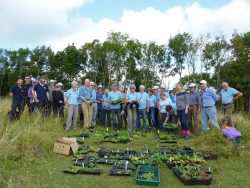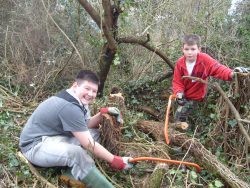WILL 2017 SEE THE DUKE RETURN TO STEYNING?
March 29, 2017
Do you have an annual ‘spring is here’ moment? That first day when the air starts to smell warmer and greener, your first sight of fruit blossom, the first cuckoo you hear? One South Downs community is on particular tenterhooks this spring.
As they enjoy the bloom of 3,000 newly planted primroses and cowslips the people of Steyning are waiting to see if this will be the year that the Duke of Burgundy butterfly returns to the hills above their town.
The South Downs chalk grassland is well known for its bright blue butterflies – the Adonis, chalkhill, common, silver studded etc. But rarer still is the tiny Duke of Burgundy. This orange and brown butterfly originally lived in woodland but, when this habitat was lost with the decline in traditional coppicing, the species moved out onto rare chalk downland. Only a handful of populations remain in Sussex.
“In 2012 there were fewer than 100 colonies of Duke of Burgundy butterflies left in the UK, most of which were very small and vulnerable,” says Tom Parry, Lead Ranger for the Central Downs part of the National Park. “On peak days of the flight season no more than 5,000 butterflies would be on the wing, and in most years far less. There was little doubt that it would take focussed and determined efforts to save its future.”
The Duke of Burgundy became one of the first species to benefit from the South Downs’ new National Park status. In 2012, working in partnership with 27 other organisations and local authorities, the National Park Authority was able to secure government funding to improve and join up chalk grassland at key points along the South Downs.
As well as rare butterflies this habitat is key to the survival of endangered farmland birds such as corn bunting and lapwing but has been in decline as this short, species-rich sward only thrives when animals like sheep or cattle are grazed.
Three years of scrub clearance and conservation grazing improved conditions for the small colony of Duke of Burgundy at Chantry Hill above Storrington. In the meantime other nearby sites were improved to be ready to host new colonies – including the hills above Steyning, just 8km away as the butterfly flutters.
Local charity the Steyning Downland Scheme has been working with the local community and connecting young people with local nature and countryside on these hills for nearly ten years. For the past two years, thanks to support from the Heritage Lottery Fund and SDNPA amongst others, they have got even more of the community involved to bring the Dukes back to Steyning.
“We’ve had a fantastic response from the start,” says Sarah Quantrill, who runs the project for the Steyning Downland Scheme. “The trouble is the Duke is so fussy! Its caterpillars live on just two plants – the cowslip and primrose – and these only thrive when the grass is properly grazed.”
There are only so many tasks you can reasonably expect your human volunteers to carry out so, on a muddy spring day in 2015, four Dexter cattle joined the regular team of volunteer scrub bashers. After a tricky journey up the steep track to their new home, which involved hitching two South Downs land rovers to the front of their trailer, they were soon to be seen and heard smashing through the densest brambles, quickly getting to grips with their job. An additional group of locals are signed up as lookerers who check on the Dexters every day to make sure they’re all ok.
 With the ground work well underway the next task for the community was having something to feed those, hopefully, hungry caterpillars. “Our volunteers collected an amazing 40,000 seeds from existing plants on the site,” continues Sarah. “The seeds were divided between 25 green-fingered locals and our project partners Kew at Wakehurst and together they managed to grow some 3,000 plants.”
With the ground work well underway the next task for the community was having something to feed those, hopefully, hungry caterpillars. “Our volunteers collected an amazing 40,000 seeds from existing plants on the site,” continues Sarah. “The seeds were divided between 25 green-fingered locals and our project partners Kew at Wakehurst and together they managed to grow some 3,000 plants.”
“We had an amazing few days last September planting these out on the hills and we’re already enjoying the first spring primroses and looking forward to the cowslips later in the season.”
So what differences have they seen on the ground so far? While their ultimate goal is to attract the Duke of Burgundy, all chalk grassland-loving butterflies will benefit. Thirty volunteers have now been trained to carry out butterfly surveys and after the first year of the project they collected 1,934 records finding 35 different species on the site. Last summer they finally spotted their first silver-studded skipper.
 Steyning Grammar School students have also been helping. “We went up on a sunny day last spring when the butterflies were on the wing and they were clearly amazed by seeing so many fluttering around them.”
Steyning Grammar School students have also been helping. “We went up on a sunny day last spring when the butterflies were on the wing and they were clearly amazed by seeing so many fluttering around them.”
So will 2017 be the year that the Duke finally returns to Steyning? Sarah is cautiously optimistic. “It’s still early days. Our plants have survived the winter and look strong and healthy but the Dukes do prefer their primroses and cowslips to be mature. That said we know they are breeding above Washington, less than 3km away. We’d be delighted if they do come this year but if not it hopefully won’t be long.”
Find out more about the project at steyningdownland.org or by emailing sdsvolunteers@gmail.com
